OPEL ANTARA 2009 Owners Manual
Manufacturer: OPEL, Model Year: 2009, Model line: ANTARA, Model: OPEL ANTARA 2009Pages: 234, PDF Size: 3.01 MB
Page 101 of 234
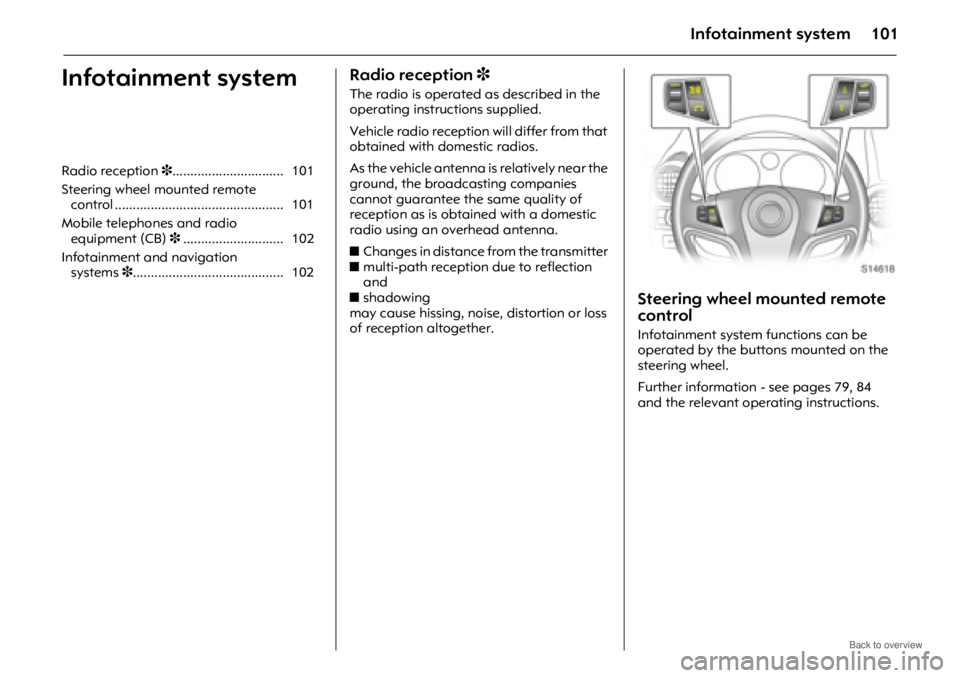
Infotainment system101
Infotainment systemRadio reception 3
The radio is operated as described in the
operating instruct ions supplied.
Vehicle radio reception will differ from that
obtained with domestic radios.
As the vehicle antenna is relatively near the
ground, the broadcasting companies
cannot guarantee the same quality of
reception as is obtained with a domestic
radio using an overhead antenna.
z Changes in distance from the transmitter
z multi-path reception due to reflection
and
z shadowing
may cause hissing, noise, distortion or loss
of reception altogether.
Steering wheel mounted remote
control
Infotainment system functions can be
operated by the buttons mounted on the
steering wheel.
Further information - see pages 79, 84
and the relevant operating instructions.
Radio reception
3............................... 101
Steering wheel mounted remote control ............................................... 101
Mobile telephones and radio equipment (CB) 3............................ 102
Infotainment and navigation systems 3.......................................... 102
Page 102 of 234

Infotainment system102
Mobile telephones and radio
equipment (CB) 3
The Opel installation instructions and the
operating guidelines provided by the
telephone manufacturer must be observed
when fitting and op erating a mobile
telephone. Failure to do so could invalidate
the vehicle’s operating permit (EU Directive
95/54/EG).
Requirements to ensure trouble-free
operation:
z Professionally installe d exterior antenna,
to obtain the maximum range possible
z Maximum transmission power 10 W.
z Installation of the telephone in a suitable
spot (front centre console).
See important notes on page 57. Obtain advice on predetermined
installation locations for the external
antenna and equipment holder and ways
of using devices with transmission power of
more than 10 Watts. We recommend that
you consult your Opel Partner, who will
have brackets and various installation kits
and install them in accordance with
regulations.
Operation of a handsfree attachment with
no outside antenna, using the mobile
telephone standards GSM 900/1800/1900
and UMTS, may take place only if the
maximum transmission power of the
mobile telephone does not exceed 2 W, in
the case of GSM 900, and otherwise 1 W.
The operating instructions of the
manufacturer of the telephone and
handsfree attachment must be noted in all
cases.
For reasons of safety, we recommend that
you do not use the phone while driving.
Even use of a handsfree set can be a
distraction while driving. Be sure to observe
any country-specific regulations.
Infotainment and navigation
systems
3
The systems are operated as described in
the instruction manuals supplied.
The navigation system is supplied with a
CD or DVD detailing the local territory.
For additional coun tries/territories,
separate CD’s are availa ble from your Opel
Partner.
9 Warning
When used in the vehicle interior, mobile
telephones and radio equipment (CB)
with integrated antenna may cause
malfunctions in the vehicle electronics.
Mobile telephones and radio equipment
( C B ) s h o u l d o n l y b e u s e d w i t h a n a n t e n n a
fitted on the vehicle exterior.
Page 103 of 234
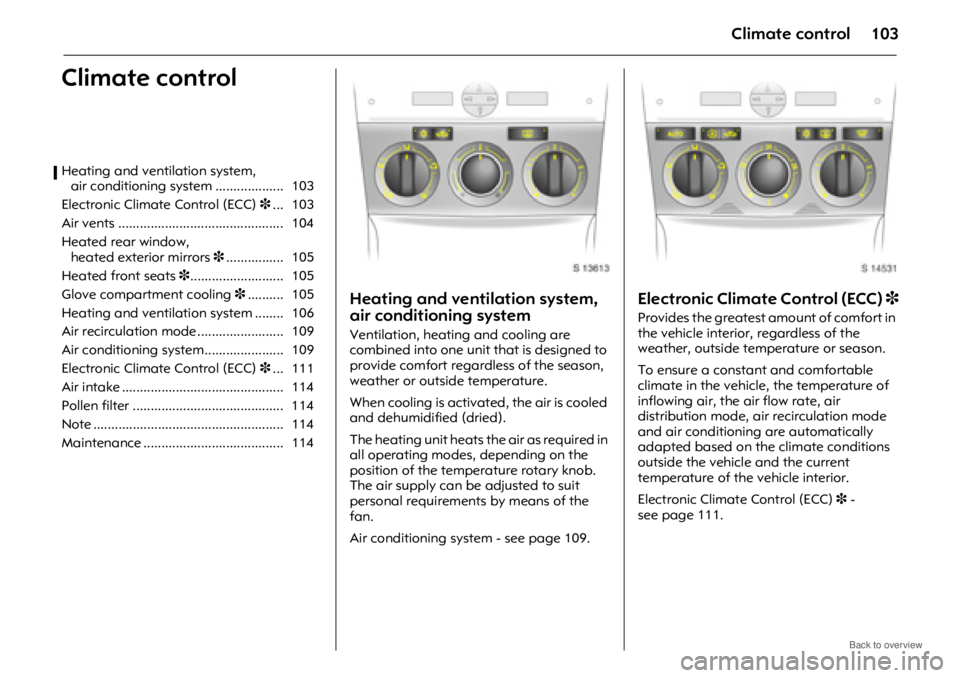
Climate control103
Climate control
Heating and ventilation system,
air conditioning system
Ventilation, heating and cooling are
combined into one unit that is designed to
provide comfort regardless of the season,
weather or outside temperature.
When cooling is activated, the air is cooled
and dehumidified (dried).
The heating unit heats the air as required in
all operating modes, depending on the
position of the temperature rotary knob.
The air supply can be adjusted to suit
personal requirements by means of the
fan.
Air conditioning system - see page 109.
Electronic Climate Control (ECC) 3
Provides the greatest amount of comfort in
the vehicle interior, regardless of the
weather, outside temperature or season.
To ensure a constant and comfortable
climate in the vehicle, the temperature of
inflowing air, the air flow rate, air
distribution mode, air recirculation mode
and air conditioning are automatically
adapted based on the climate conditions
outside the vehicle and the current
temperature of the vehicle interior.
Electronic Climate Control (ECC) 3 -
see page 111.
Heating and ventilation system,
air conditioning system ................... 103
Electronic Climate Control (ECC) 3... 103
Air vents .............................................. 104
Heated rear window, heated exterior mirrors 3................ 105
Heated front seats 3.......................... 105
Glove compartment cooling 3.......... 105
Heating and ventilation system ........ 106
Air recirculation mode ........................ 109
Air conditioning system...................... 109
Electronic Climate Control (ECC) 3... 111
Air intake ............................................. 114
Pollen filter .......................................... 114
Note ..................................................... 114
Maintenance ....................................... 114
Page 104 of 234
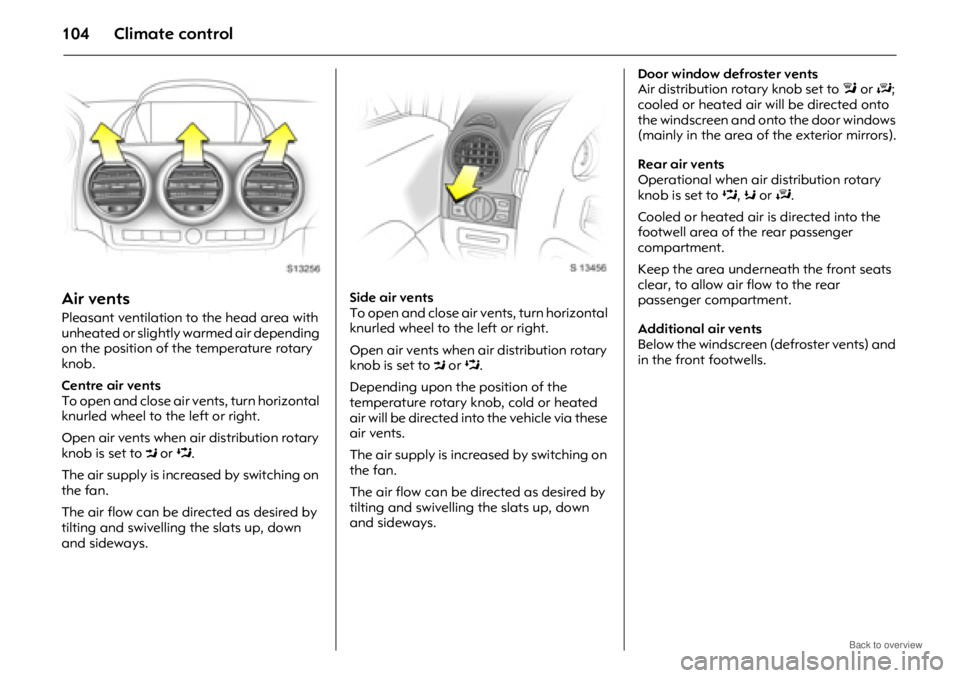
Climate control104
Air vents
Pleasant ventilation to the head area with
unheated or slightly warmed air depending
on the position of the temperature rotary
knob.
Centre air vents
To open and close air vents, turn horizontal
knurled wheel to the left or right.
Open air vents when air distribution rotary
knob is set to M or L.
The air supply is increased by switching on
the fan.
The air flow can be directed as desired by
tilting and swivelling the slats up, down
and sideways. Side air vents
To open and close air ve
nts, turn horizontal
knurled wheel to the left or right.
Open air vents when air distribution rotary
knob is set to M or L.
Depending upon the position of the
temperature rotary knob, cold or heated
air will be directed into the vehicle via these
air vents.
The air supply is increased by switching on
the fan.
The air flow can be directed as desired by
tilting and swivelling the slats up, down
and sideways. Door window defroster vents
Air distribution rotary knob set to
l or J ;
cooled or heated air wi ll be directed onto
the windscreen and onto the door windows
(mainly in the area of the exterior mirrors).
Rear air vents
Operational when air distribution rotary
knob is set to L, K or J .
Cooled or heated air is directed into the
footwell area of the rear passenger
compartment.
Keep the area underneath the front seats
clear, to allow air flow to the rear
passenger compartment.
Additional air vents
Below the windscreen (defroster vents) and
in the front footwells.
Page 105 of 234

Climate control105
Heated rear window,
heated exterior mirrors 3
Operational only in ignition switch
positions ACC or ON.
Control indicator in button.
Turn off as soon as vision is clear.
Rear window and exterior mirror heating is
switched off automatically after approx.
15 minutes.
To avoid discharging the battery, do not
operate when you are just starting the
vehicle, or if there is a build up of snow or
ice. Operate only with the engine running.
Do not use sharp instruments or abrasive
cleaners on rear window or exterior mirrors,
and avoid scratching or damaging their
heating elements.
Heated front seats 3
Operational only in ignition switch
positions ACC or ON.
Press switch ß on respective side one or
more times to set the desired heat output.
Control indicator in switch indicates which
of the three heating levels is active.
To switch heating off, set heat output to
the lowest level and press the switch again.
The control indicato r will extinguish.
Prolonged use could cause damage to
delicate and thin clothing and burn seat
occupants.
Avoid subjecting seats to heavy impacts,
as this may cause damage to the heating
element.
If temperature continues to rise, turn seat
heating off and consult a workshop.
Glove compartment cooling 3
Cooled air is fed into the glove
compartment through an air opening,
when the air conditioning is turned on.
Rotate adjustment wheel anti-clockwise to
allow the air conditioning to keep the
contents of the glove compartment cool.
Rotate adjustment wheel clockwise to close
air opening when glove compartment
cooling is not required.
General notes and notes on air intake,
pollen filter and maintenance
see page 114.
Press button
Ü=On
Press button Ü again = Off
Page 106 of 234
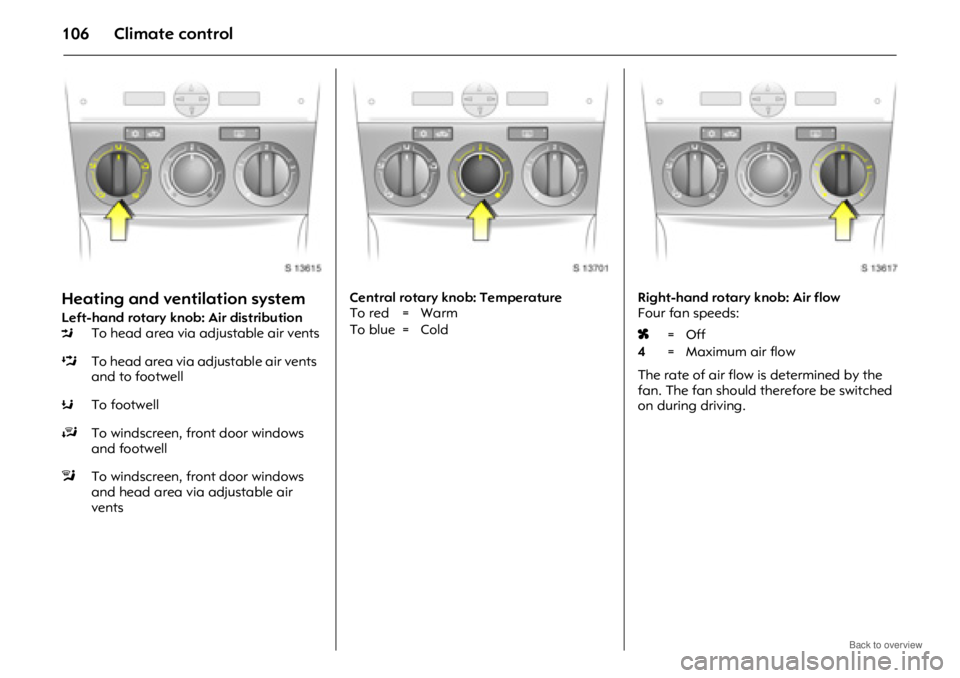
Climate control106
Heating and ventilation system
Left-hand rotary knob: Air distributionCentral rotary knob: Temperature Right-hand rotary knob: Air flow
Four fan speeds:
The rate of air flow is determined by the
fan. The fan should therefore be switched
on during driving.
M
To head area via adjustable air vents
L To head area via adjustable air vents
and to footwell
K To footwell
J To windscreen, front door windows
and footwell
l To windscreen, front door windows
and head area via adjustable air
ventsTo red = Warm
To blue = Cold
x=Off
4 = Maximum air flow
Page 107 of 234

Climate control107
Ventilation
zTurn air recirculation mode 4 off.
z For maximum ventilation to head area:
set air distribution rotary knob to M.
z For ventilation to footwell:
set air distribution rotary knob to K.
z For simultaneous ventilation to head
area and footwell:
set air distribution rotary knob to L.
z Turn temperature rotary knob to blue
area for cooling.
z Set fan to desired speed.
z Open adjustable centre and side air
vents. Heating
The amount of heat is dependent on the
engine temperature and is thus not fully
attained until the engine is warm.
For rapid warming of the passenger’s
compartment:
z
Activate air recirculation mode 4.
z Set the air distribution rotary knob to
K or L .
z Turn temperature ro tary knob to red
area for warm air.
z Set fan to 4 .
z Open adjustable side air vents.
Do not use this setting for extended
periods, as gradual deterioration in air
quality and an increase in humidity may
cause windows to mist up. To obtain a temperat
ure for a "cool head
and warm feet" effect:
z Turn air recirculation mode 4 off.
z Set the air distribution rotary knob to L.
z Turn temperature rotary knob to the
middle.
z Set fan to desired speed.
z Open adjustable centre and side air
vents.
The comfort and general wellbeing of
vehicle occupants are to a large extent
dependent on a suitab le ventilation and
heating setting.
Page 108 of 234
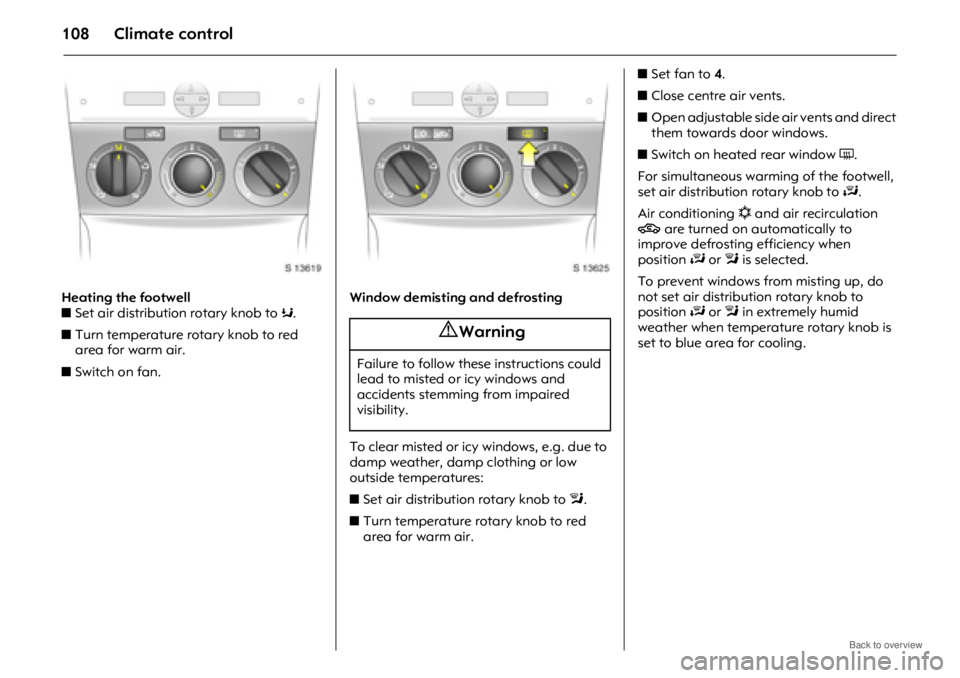
Climate control108
Heating the footwell
zSet air distribution rotary knob to K.
z Turn temperature rotary knob to red
area for warm air.
z Switch on fan. Window demisting and defrosting
To clear misted or icy
windows, e.g. due to
damp weather, damp clothing or low
outside temperatures:
z Set air distribution rotary knob to l.
z Turn temperature ro tary knob to red
area for warm air. z
Set fan to 4.
z Close centre air vents.
z Open adjustable side air vents and direct
them towards door windows.
z Switch on heated rear window Ü.
For simultaneous warming of the footwell,
set air distribution rotary knob to J.
Air conditioning n and air recirculation
4 are turned on automatically to
improve defrosting efficiency when
position J or l is selected.
To prevent windows from misting up, do
not set air distribution rotary knob to
position J or l in extremely humid
weather when temperature rotary knob is
set to blue area for cooling.
9 Warning
Failure to follow thes e instructions could
lead to misted or icy windows and
accidents stemming from impaired
visibility.
Page 109 of 234
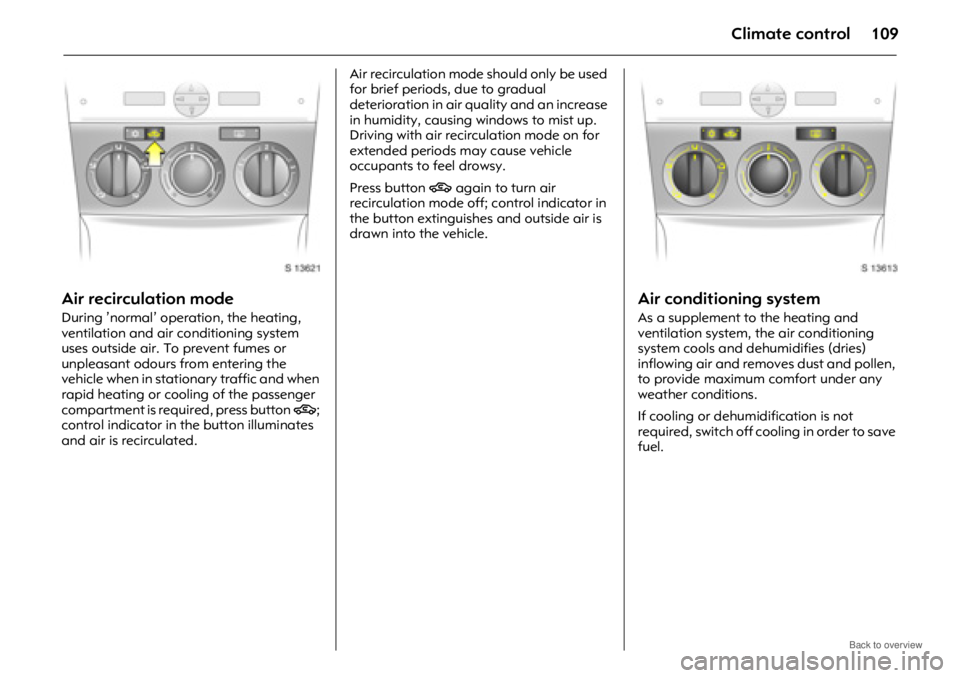
Climate control109
Air recirculation mode
During ’normal’ operation, the heating,
ventilation and air co nditioning system
uses outside air. To prevent fumes or
unpleasant odours from entering the
vehicle when in stationary traffic and when
rapid heating or cooling of the passenger
compartment is required, press button 4;
control indicator in the button illuminates
and air is recirculated. Air recirculation mode should only be used
for brief periods, due to gradual
deterioration in air quality and an increase
in humidity, causing windows to mist up.
Driving with air recirculation mode on for
extended periods may cause vehicle
occupants to feel drowsy.
Press button
4 again to turn air
recirculation mode off; control indicator in
the button extinguishes and outside air is
drawn into the vehicle.
Air conditioning system
As a supplement to the heating and
ventilation system, the air conditioning
system cools and dehumidifies (dries)
inflowing air and removes dust and pollen,
to provide maximum comfort under any
weather conditions.
If cooling or dehumi dification is not
required, switch off cooling in order to save
fuel.
Page 110 of 234
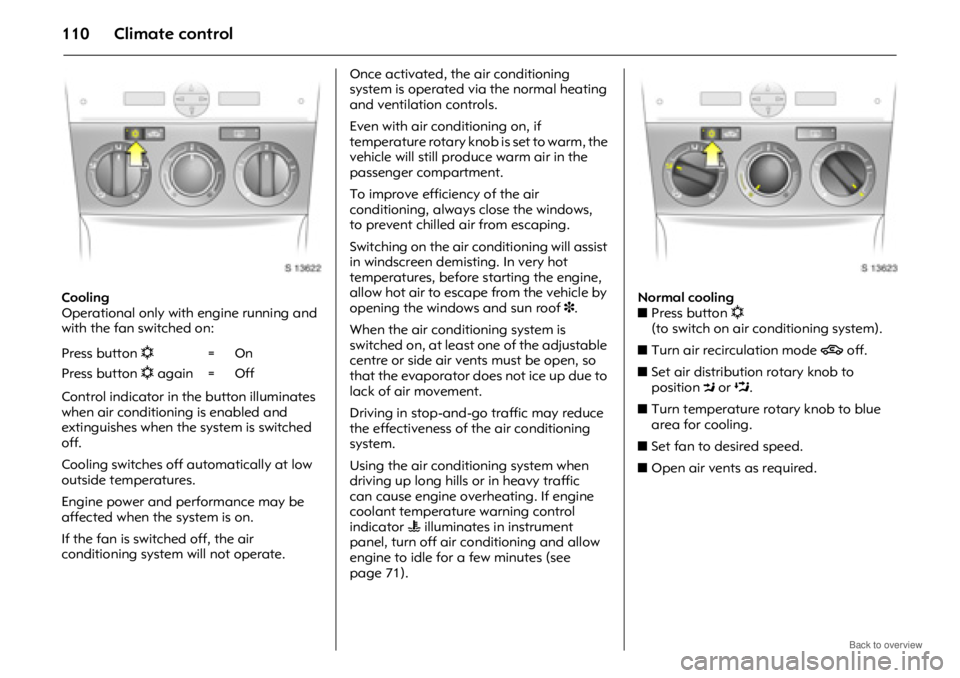
Climate control110
Cooling
Operational only with engine running and
with the fan switched on:
Control indicator in the button illuminates
when air conditioning is enabled and
extinguishes when the system is switched
off.
Cooling switches off automatically at low
outside temperatures.
Engine power and performance may be
affected when the system is on.
If the fan is switched off, the air
conditioning system will not operate. Once activated, the air conditioning
system is operated via the normal heating
and ventilation controls.
Even with air conditioning on, if
temperature rotary knob is set to warm, the
vehicle will still produce warm air in the
passenger compartment.
To improve efficiency of the air
conditioning, always close the windows,
to prevent chilled air from escaping.
Switching on the air conditioning will assist
in windscreen demisting. In very hot
temperatures, before starting the engine,
allow hot air to escape from the vehicle by
opening the windows and sun roof
3.
When the air conditioning system is
switched on, at least one of the adjustable
centre or side air vents must be open, so
that the evaporator does not ice up due to
lack of air movement.
Driving in stop-and-go traffic may reduce
the effectiveness of the air conditioning
system.
Using the air conditioning system when
driving up long hills or in heavy traffic
can cause engine overheating. If engine
coolant temperature warning control
indicator W illuminates in instrument
panel, turn off air co nditioning and allow
engine to idle for a few minutes (see
page 71). Normal cooling
z
Press button n
(to switch on air co nditioning system).
z Turn air recirculation mode 4 off.
z Set air distribution rotary knob to
position M or L.
z Turn temperature rotary knob to blue
area for cooling.
z Set fan to desired speed.
z Open air vents as required.
Press button
n=On
Press button n again = Off